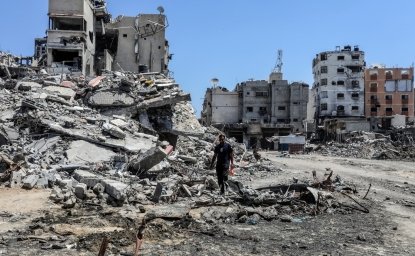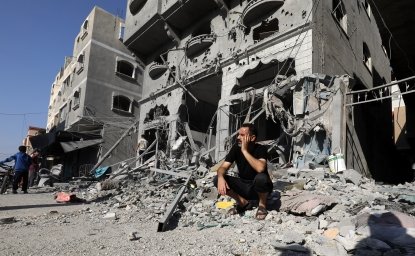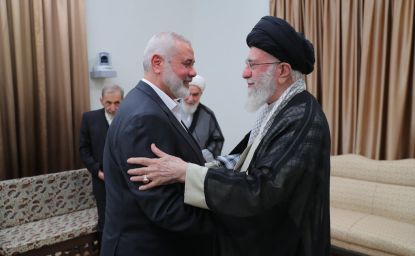By early 2016, the Islamic State - also known as ISIS, ISIL, or Daesh - had faced severe setbacks. Although ISIS remained entrenched in its strongholds, more than a year of U.S. and coalition airstrikes had diminished the group's infrastructure, number of fighters, finances, and social media presence. On February 25, President Obama said that ISIS was under "severe pressure." But he also emphasized that the only way to defeat ISIS is to "end the chaos and civil war that has engulfed Syria."
Secretary of State John Kerry suggested that ISIS's attack in Brussels, Belgium on March 22, along with its threats to carry out more attacks in Europe, reflected the group's battlefield losses in Iraq and Syria. "The very reason that Daesh is resorting to actions outside of the Middle East is that its fantasy of a caliphate is collapsing before their eyes," he said in Brussels on March 25. "Its territory is shrinking every day, its leaders are being decimated, its revenue sources are dwindling, and its fighters are fleeing." By late March, Iraqi troops had launched an offensive on Mosul, seeking to recapture the key ISIS stronghold. The following facts and figures summarize ISIS losses by early 2016.
Infrastructure
- As of March 7, 2016, the United States and its coalition partners had conducted 10,809 airstrikes against ISIS targets - 7,225 in Iraq and 3,584 in Syria. The airstrikes had damaged or destroyed 21,501 ISIS targets.
- The United States has conducted more than 8,000 of the strikes.
- Airstrikes had killed around 20,000 ISIS fighters by the end of 2015. In December 2015 alone, airstrikes killed around 2,500 ISIS fighters.
- As of January 2016, the United States had spent $6.2 billion on the air campaign. The daily cost increased from $9.1 million per day in June 2015 to around $11.5 million per day by January 2016.
#CJTFOIR airstrikes are having a huge impact on anti-ISIL operations in Iraq and Syria #InherentResolve pic.twitter.com/oypzTqVzdG
— Inherent Resolve (@CJTFOIR) February 21, 2016
Territory
- ISIS has lost 40 percent of its territory in Iraq, including the key Sunni cities of Ramadi and Tikrit, as well as the Bayji oil refinery and Sinjar. Around 95 percent of the population has returned to Tikrit.
- In Syria, ISIS has lost more than 10 percent of its territory, including Kobani, al Hawl, Tishreen, and Tal Abyad. More than 6,000 ISIS fighters were killed in the six-month battle for Kobani. But the fighting also resulted in the deaths of 1,000 U.S.-allied fighters on the ground.
- ISIS has not launched a major offensive since May 2015.
New ISW #ISIS Sanctuary Map. ISIS loses in some areas but strikes back in others. https://t.co/9o7dZxICKB pic.twitter.com/uHzKouPs5q
— ISW (@TheStudyofWar) March 3, 2016
Fighters
- The number of foreign fighters flocking to the Islamic State is declining. ISIS had around 31,500 foreign fighters in mid-2014. By early 2016, it dropped to around 25,000. Fighters come from more than 100 countries. Efforts to disrupt foreign fighter networks have led to more than 30 FBI investigations.
- Up to 250 fighters from the United States have attempted to travel to Iraq and Syria to join armed groups.
- Despite its losses, ISIS has established formal affiliates in at least eight countries outside Iraq and Syria – Libya, Algeria, Yemen, Egypt, Saudi Arabia, Afghanistan, Russia, and Nigeria. Most affiliates were formed from preexisting jihadist groups who declared allegiance to the Islamic State. The most powerful affiliate is in Libya, which has up to 6,500 fighters.

Source: House Homeland Security Committee
Revenues
- ISIS receives around $1 billion in annual revenues. The group obtains funds by smuggling oil, selling drugs and antiquities, kidnapping for ransom, and taxing citizens in areas it controls.
- ISIS faced a budget shortfall by early 2016, forcing it to cut its fighters’ salaries by around 50 percent and increase taxes.
- In 2015, ISIS got around half of its revenue from oil, amounting to $500 million. ISIS controls more than 80 percent of Syria’s oil infrastructure.
- More than 100 ISIS fighters oversee and manage its energy resources, but many of them have been killed or can no longer operate openly.
- U.S. airstrikes on ISIS’s oil infrastructure have curbed its production capacity. Oil production has been cut by 30 percent, dropping from 50,000-70,000 barrels per day in 2014 to 20,000-34,000 barrels per day by late 2015.
Social Media
- Twitter has shut down around 125,000 ISIS-affiliated accounts since mid-2015. Facebook and YouTube are also working to shut down accounts.
- Efforts to suspend pro-ISIS Twitter accounts have held the network “relatively flat” and reduced the reach of pro-ISIS users, according to a study by the George Washington University’s Program on Extremism.
Source: Unless otherwise noted, facts and figures are from Special Presidential Envoy for the Global Coalition to Counter ISIL Brett McGurk, who testified to the House Foreign Affairs Committee on Feb. 10, 2016.
Author

The Islamists
Learn more about Hamas and how it relates to similarly aligned organizations throughout the region. Read more

Explore More
Browse Insights & Analysis
Israel Escalates Attacks in Gaza: What’s Next?

Israel Expands Operations on Multiple Fronts: Perspectives on the Conflict

